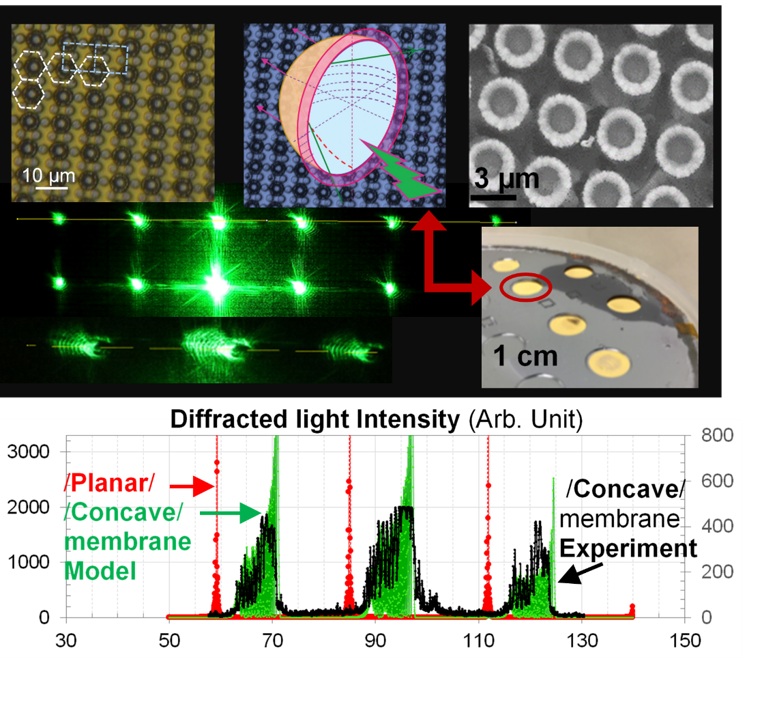Numerous studies investigated the use of synthetic membranes for photonic or biomedical applications. We report here on a recent type of biocompatible magnetically actuated membranes, partly originating from studies on magnetic particles for biology, consisting of PDMS/Au bilayers with embedded arrays of micrometric magnetic pillars. Flat at zero field, concave in an applied magnetic field, they turned out to constitute magnetically tunable diffraction gratings, with magnetically controlled optical responses fitted by our analytic magneto-mechanical-optical model in excellent agreement.
Artificial membranes are more and more explored for various applications. In particular in biology, for understanding the living or acting on it with therapeutic purposes, or in optics-related fields as flexible photonic devices. Biology and optics being potentially linked for instance in vision studies. Moreover, the great potential of elastic membranes embedding magnetic particles, lies in their ability to be remotely actuable by an external magnetic field.
On this basis, we report here on a new type of magneto-elastic membrane recently developed at SPINTEC. Our films are constituted of polydimethylsiloxane (PDMS)/Au bilayers (5μm/100nm-thick) with embedded arrays of permalloy pillars, prepared by lithography techniques at the Platform PTA. PDMS films are indeed renowned for their tunable elastic modulus, biocompatibility and optical properties (high transparency).
Our membranes, suspended over apertures created in their silicon substrates, were tested by a set of optical experiments. The study included their magnetic and elastic characterization and modelling. In particular, the expression of magnetic forces exerted by a permanent magnet, enabled the membranes deflections calculation.
We showed that membranes, flat or deformed by the applied magnetic field, illuminated by a laser beam, produced a very strong optical response to the magnetic field in reflection, depending on their microstructure and concavity.
Our membranes turned out to constitute thus magnetically tunable optical diffraction gratings for visible light wavelengths, in reflection. The diffraction patterns of the ~1cm-diameter-membranes could be significantly modified by slight membrane deflections, in the range of 50 µm down to a few hundreds of nm. The complete study being published in Nanoscale, 2019, 11, H. Joisten et al.
More generally, these results suggest that this type of biocompatible actuable magneto-elastic membranes presents potential applications in adaptive optics, photonic devices, as well as in biophysics, biology and biomedical applications. Highly multidisciplinary, such studies may address micro- nano- magnetism, optics and photonics science, as well as biological and biomedical research.
Team: Health and Biology
Collaboration: IRIG / SyMMES (biochemistry and surfaces treatments). Technology at PTA.
Funding: EU’s Horizon 2020 research and innovation program under grant agreement No 665440.
Further reading: Optical response of magnetically actuated biocompatible membranes, H. Joisten, A. Truong, S. Ponomareva, C. Naud, R. Morel, Y. Hou, I. Joumard, S. Auffret, P. Sabon and B. Dieny, Nanoscale, 2019, 11, 10667-10683. DOI: 10.1039/C9NR00585D
Contact: Helene Joisten

Figure: Sketch and photo of suspended magnetoelastic membranes (8mm-diameter) on their Si substrate, and optical/SEM imaging of the embedded magnetic micro-pillars arrays, yielding flexible and magnetically tunable diffraction gratings.




